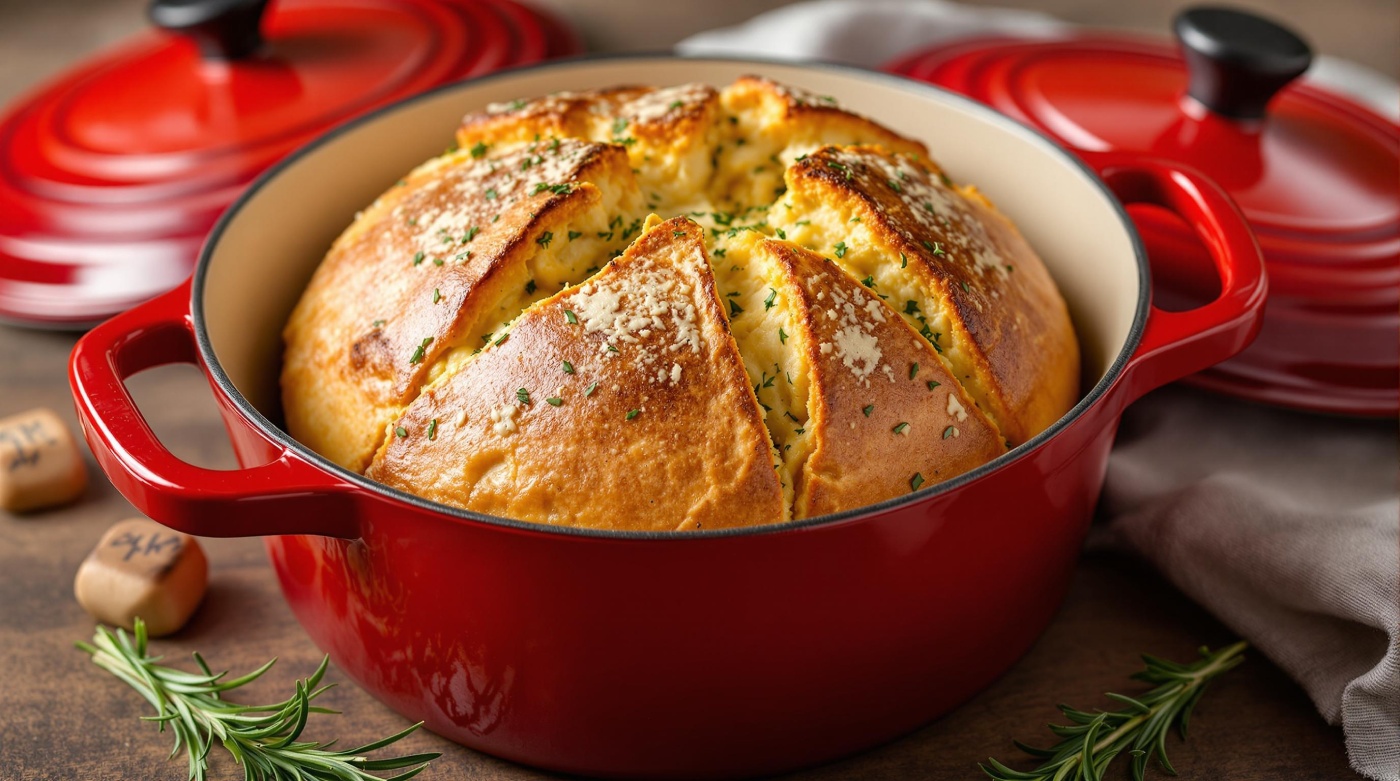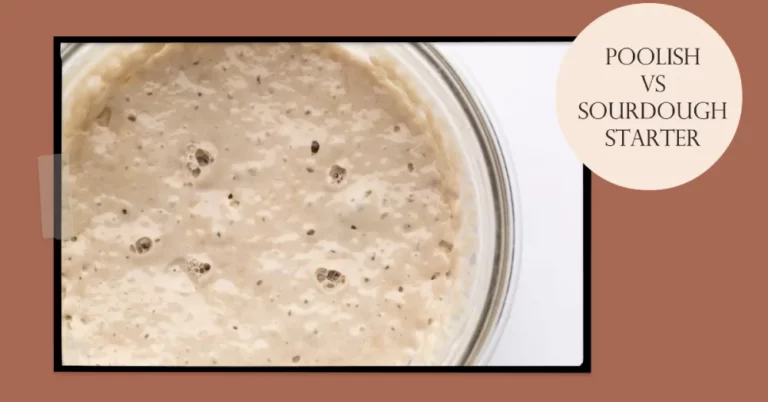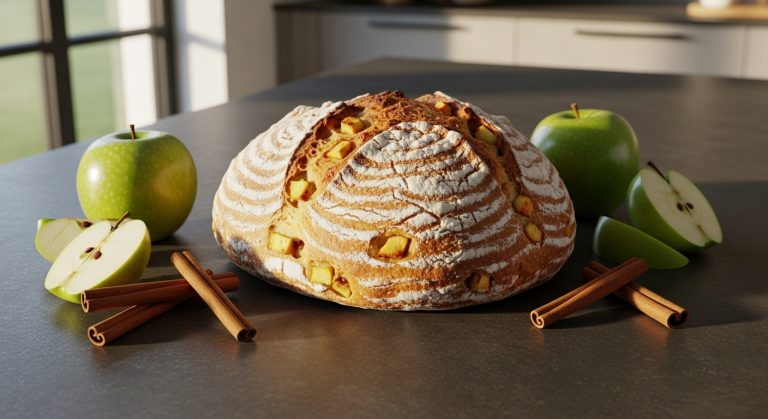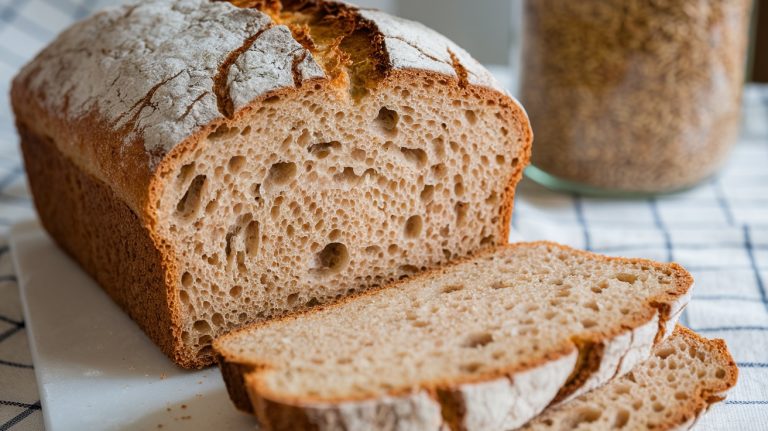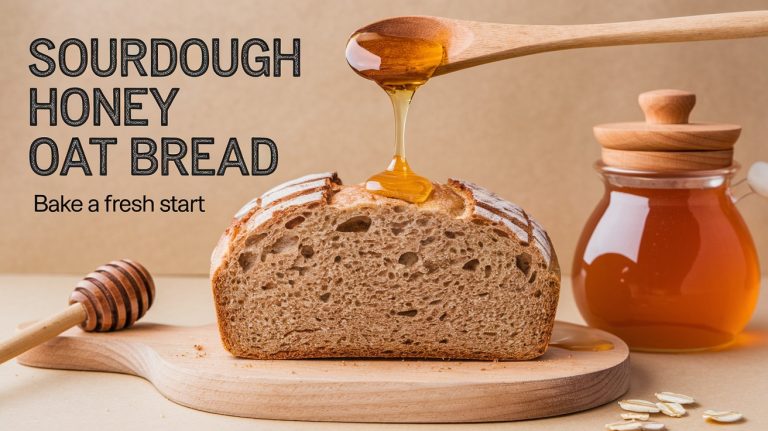Italian Herb and Cheese Sourdough Bread: Melt-in-Your-Mouth Magic
Italian herb and cheese sourdough bread offers a mouthwatering blend of tangy sourdough and rich, savory flavors. You’ll love the stretchy pockets of melted cheese paired with aromatic herbs like basil and rosemary.
This bread’s crispy crust and chewy crumb are perfect for sandwiches or simply enjoyed warm with butter. Elevate your baking by experimenting with various cheeses and herbs, or discover the perfect wine pairing to complement your creation.
Taste the magic that awaits you.
Key Takeaways
- Combine strong flavor cheeses like sharp cheddar and Gruyère with Italian herbs for a rich, savory sourdough experience.
- Use high-protein bread flour for structure and achieve the right hydration for a well-formed dough.
- Incorporate fresh herbs like basil and rosemary during the lamination or stretch and fold stages for enhanced flavor complexity.
- Serve the bread as a pull-apart option with garlic herb butter or transform it into bruschetta with fresh toppings.
- Store the sourdough in a paper bag or cloth wrap to maintain its crunchy crust and extend freshness.
Key Ingredients for Flavorful Sourdough
When crafting a flavorful sourdough, the key ingredients set the stage for a delightful culinary experience. Start with cheeses that boast strong flavor profiles, like sharp cheddar or Gruyère, to guarantee each bite bursts with taste.
High-moisture cheeses melt better and create stretchy pockets in the bread, enhancing the overall texture. Shred your cheese for even distribution, avoiding pre-shredded varieties that can hinder melt quality.
Incorporate an Italian herb blend, using fresh basil or oregano for vibrant flavors, or mix in dried herbs for depth. Don’t forget the flour; choose high-protein bread flour for structure, while whole wheat or rye adds complexity.
Finally, salt enhances flavors and supports the dough’s strength. Additionally, using whole grain spelt flour can provide rich flavors and nutritional benefits, ensuring your sourdough is both delicious and memorable.
Understanding the Flavor Profile
Understanding the flavor profile of Italian herb and cheese sourdough bread reveals a delightful symphony of tastes that dance on your palate.
The tangy sourdough base adds complexity, perfectly contrasting with the savory, aromatic notes of Italian herbs like basil and rosemary. Each bite introduces a rich layer of cheese, whether it’s the sharp nuttiness of Parmesan or the creamy melt of mozzarella, enhancing the overall experience. Additionally, this bread is ideal for exploring sourdough inclusions, allowing you to experiment with various flavors that can elevate your baking. Fresh herbs like rosemary can further enhance the flavor complexity, making each bite a more exciting experience.
The tangy sourdough beautifully complements the savory Italian herbs and rich cheese, creating a delightful culinary experience.
Garlic infuses a bold pungency that lingers, while the interplay of textures—from the crispy crust to the chewy crumb—offers a sensory delight.
This bread isn’t just a side; it’s a versatile companion, whether enjoyed plain, with butter, or as a scrumptious sandwich base.
Essential Baking Process Highlights
As you commence on crafting your Italian herb and cheese sourdough bread, understanding essential baking processes is vital.
You’ll want to master levain preparation techniques, ensuring your starter is lively and ready to work its magic. A slight deflation in your starter indicates it is still sufficient for feeding, so don’t worry if it appears a bit less puffy. Additionally, be mindful of achieving the ideal hydration level to ensure a well-structured dough.
Then, focus on bulk fermentation essentials to achieve that airy texture, followed by insightful baking methods that promise a golden crust and unforgettable flavor.
Levain Preparation Techniques
To create a vibrant levain that breathes life into your Italian Herb and Cheese Sourdough Bread, you’ll want to pay close attention to the feeding ratios and fermentation conditions.
Start with a mature starter, and choose a ratio like 1:2:2 for a quick fermentation, or 1:10:10 for a slower build. Keep the temperature between 75-80°F to optimize growth. Additionally, sourdough fermentation allows for complex flavor development over time. Remember that a fed starter is crucial for achieving consistent performance in your baking.
In about 5-12 hours, your levain should double or triple in size, with a bubbly surface and a pleasant, sour aroma. For best results, conduct the float test—if it floats in water, it’s ready.
Adjust flour types to match your recipe, and don’t forget to build a bit more than needed to account for transfer loss.
Bulk Fermentation Essentials
After nurturing the levain to perfection, it’s time to embrace the magic of bulk fermentation. This essential phase transforms your dough into a flavorful masterpiece. During this period, the dough ferments as one large mass, developing acidity and structure.
Ideally, keep your dough between 74-82°F for 2-5 hours, monitoring closely for that perfect rise. Remember that bulk fermentation is crucial for enhancing the dough’s flavor and texture, and performing stretches and folds during this time will significantly improve the dough’s strength.
| Key Factors | Ideal Conditions | Observations |
|---|---|---|
| Temperature | 74-82°F (23-28°C) | Smooth surface, visible bubbles |
| Duration | 2-5 hours (warm temps) | Significant volume increase |
| Folds Techniques | Stretch & folds every 30-45m | Light, airy, jiggly texture |
Pay close attention to these signs to achieve that airy, delicious sourdough!
Baking Method Insights
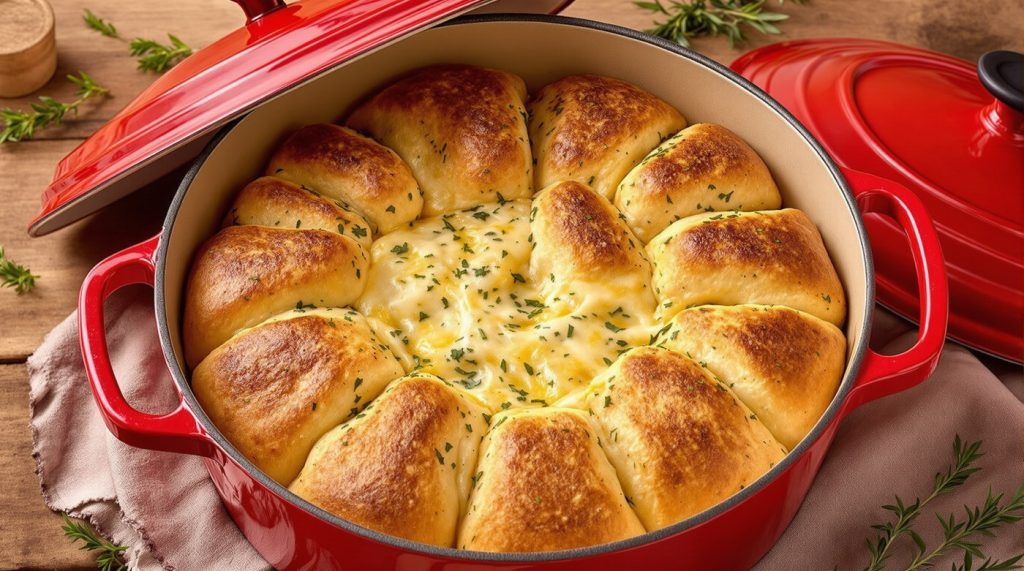
When you immerse yourself in the baking process, every step from shaping to cooling plays an essential role in achieving that perfect Italian herb and cheese sourdough.
Begin by incorporating herbs and cheese during lamination or the stretch and fold stages, ensuring even distribution without tearing the dough. Adding inclusions during the stretch and fold allows for better integration of flavors. It’s crucial to score the dough just before placing it in the oven to achieve optimal expansion and crust quality.
For final proofing, remember that cheese can slow fermentation, so adjust your timing accordingly, whether you choose cold or room temperature proofing.
As you score the cold dough, use a sharp blade for clean cuts, maintaining confidence to avoid drag. Scoring at a 30-45 degree angle helps maximize the loaf’s rise during baking.
Preheat your oven thoroughly, utilizing steam for that coveted crust.
Finally, cool your loaf completely on a wire rack to enhance texture, ensuring each slice reveals a delightful crumb.
Exploring Variations and Additions
As you commence on the journey of crafting Italian Herb and Cheese Sourdough Bread, consider the delightful possibilities that variations and additions bring to your loaf. Experimenting with different herbs and cheeses can elevate your bread to new heights. Here’s a quick reference table:
| Herb Variations | Cheese Options | Savory Additions |
|---|---|---|
| Fresh rosemary | Sharp cheddar | Roasted garlic |
| Dried Italian blend | Provolone | Sun-dried tomatoes |
| Thyme and rosemary | Gruyère | Chopped Kalamata olives |
| Lightly dried basil | Young mozzarella | Diced jalapeños |
Incorporate these during your stretch and fold stages for a burst of flavor. Remember, a little creativity goes a long way in transforming your sourdough experience! Sourdough starter adds depth and balance, making each variation even more exciting. Additionally, using higher protein bread flour enhances gluten development, resulting in a better rise and texture for your loaf.
Creative Serving Suggestions
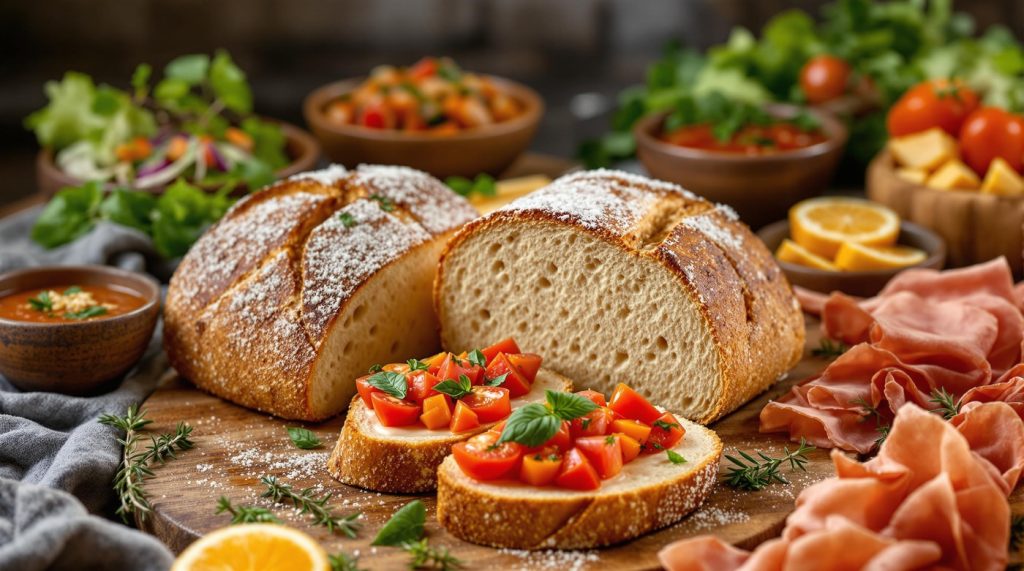
Exploring the unique flavors of Italian Herb and Cheese Sourdough Bread opens up a world of creative serving suggestions that can enhance any meal or gathering.
Try a pull-apart bread, stuffed with garlic herb butter and mozzarella, perfect for entertaining. For a lighter option, slice it thin, toast, and serve alongside dips or salads. Each bite offers crispy, cheesy goodness, making it a delightful addition to any appetizer spread. Additionally, the use of high-quality flour options can elevate the flavor and texture of your bread, making it even more enjoyable.
Elevate your gatherings with pull-apart bread filled with garlic herb butter and mozzarella, or enjoy thinly sliced, toasted bread with dips and salads.
Transform it into bruschetta topped with fresh tomatoes and basil or as a centerpiece on a charcuterie board. Consider it for gourmet grilled cheese or hearty sandwiches filled with Italian cold cuts. Pair it with soups, salads, or serve it as a side for chili. With these ideas, your sourdough bread can shine in any culinary setting!
Nutritional Aspects of Sourdough Bread
While you savor the delightful taste of Italian Herb and Cheese Sourdough Bread, it’s essential to appreciate its nutritional benefits.
Each slice, packed with 185-188 calories, offers a satisfying balance of about 36-37g of carbohydrates and 2-8g of protein, depending on the flour used.
The fermentation process enhances its digestibility, making nutrients like B vitamins and minerals more accessible. Additionally, the fermentation process significantly reduces phytate content, which helps in enhancing mineral absorption. The prebiotic content in sourdough further supports the growth of beneficial gut bacteria, promoting overall digestive health.
With a lower glycemic index than standard breads, it promotes steadier blood sugar levels.
Plus, the presence of prebiotics nurtures your gut health.
Tips for Perfecting Your Sourdough
To achieve perfect sourdough, focus on activating your starter at its peak—when it’s bubbly and has doubled in size. Maintaining an ideal fermentation temperature around 75-78°F guarantees your dough rises beautifully without risking over or under fermentation.
Regular feedings keep the starter active and enhance its flavor profile, ensuring that these simple adjustments can elevate your sourdough from good to extraordinary, enhancing both flavor and texture. Additionally, proper identification of hooch will help you maintain your starter’s health and prevent contamination.
Starter Activation Tips
When you nurture your sourdough starter, understanding the nuances of its activation can make all the difference in your baking journey.
Keep these tips in mind for a thriving starter:
- Feed Regularly: Stick to a consistent feeding schedule to keep your starter active and predictable. Regular feeding helps maintain a bubbly, active starter, and patience is crucial for starters that have been dormant.
- Watch for Bubbles: Look for visible bubbles and a spongy texture; these signs indicate your starter is ready for baking.
- Optimize Ingredients: Use whole grain flour and filtered water to enhance nutrient availability, and adjust water for the right consistency. A starter typically takes about 7 days to establish and requires regular feedings to remain active.
Ideal Fermentation Temperature
Nurturing your sourdough starter lays the groundwork for the perfect loaf, but the ideal fermentation temperature can elevate your baking to new heights. Aim for a final dough temperature between 75°F and 78°F (24°C to 25°C) to spark vigorous fermentation.
Within the sweet spot of 76°F to 80°F (24°C to 27°C), yeast thrives, enhancing volume and flavor. Be cautious with warmer temperatures; while they speed up fermentation, they can lead to over-proofing and a gummy crumb.
Conversely, cooler conditions slow the rise, allowing for deeper, tangy flavors through longer fermentation. Utilizing a thermometer to monitor temperatures closely is essential for achieving the ideal proofing temperature, ensuring your dough develops the perfect texture and taste for that delightful Italian herb and cheese bread you crave.
Troubleshooting Common Issues
Although baking Italian herb and cheese sourdough bread can be a rewarding endeavor, it often comes with its share of challenges.
To overcome common issues, keep these tips in mind:
- Starter Activity: Make certain your starter is active and bubbly; a weak starter leads to dense bread. Consistent feedings can help revive dormant starters and boost their activity.
- Dough Stickiness: If your dough is too sticky, reduce water or guarantee proper gluten development through kneading.
- Proofing Errors: Monitor your dough’s volume and temperature closely; under-proofing results in dense, gummy bread, while over-proofing can cause it to collapse.
Storing and Freshening Your Sourdough
Properly storing and freshening your Italian herb and cheese sourdough bread is essential to preserve its delightful flavors and texture. Start by letting your bread cool completely before storage to avoid sogginess. Use a paper bag or wrap it in a cloth to maintain that crunchy crust. Proper storage techniques can extend the freshness and enjoyment of your bread for several days.
If your bread begins to stale, revive it with these handy tips:
- Briefly run the crust under water, wrap it in foil, and bake at 300-390°F for 5-15 minutes.
- Alternatively, freeze slices before they stale for easy access later.
- For thawing, place the whole loaf wrapped at room temperature or toast slices directly.
Frequently Asked Questions
Can I Use Gluten-Free Flour for This Sourdough Recipe?
Yes, you can use gluten-free flour for sourdough recipes, but it requires some adjustments.
Opt for gluten-free blends specifically designed for bread, or experiment with whole grain flours like brown rice or sorghum.
Make sure your starter is active and healthy.
Adding psyllium husk can enhance the dough’s texture, while proper hydration is essential to avoid dense loaves.
How Long Does the Sourdough Starter Last?
Your sourdough starter’s lifespan depends on how you store it.
At room temperature, it needs feeding every 12-24 hours and can last about 1-2 weeks unfed.
In the fridge, it slows down and can survive for weeks without food, especially if it’s mature.
For long-term storage, drying it preserves it indefinitely.
Reviving a neglected starter is possible; just feed it regularly until it shows signs of life again.
Can I Freeze the Baked Sourdough Bread?
Absolutely, you can freeze that glorious loaf of baked sourdough bread!
Imagine stashing away slices of crusty perfection for future toasty indulgence. Just make sure it cools completely first—no one wants soggy bread!
Slice it up for easy access or freeze it whole. Wrap it tightly to keep freezer burn at bay, and you’ll savor its delightful taste for months.
When you’re ready, thaw it slowly for that fresh-baked magic!
What Is the Best Way to Refresh My Sourdough Starter?
To refresh your sourdough starter, start by discarding half of it.
Then, weigh equal parts flour and water—typically a 1:1:1 ratio—and mix it in thoroughly.
Cover the jar loosely and let it rise at room temperature until it’s bubbly and doubled, usually within 2 to 12 hours.
Keep an eye on the temperature; a warm environment (around 75°F/23°C) encourages lively fermentation.
Regular feeding keeps your starter strong and ready for baking!
How Can I Tell When My Dough Has Risen Enough?
Isn’t it amusing how we obsess over dough rising, yet sometimes forget the simplest signs?
To know your dough’s ready, look for a 50-100% volume increase, with a smooth, slightly domed surface. Bubbles should peek beneath the surface, and if you give it a gentle wiggle, it should bounce back.
Try the poke test—if it springs back slowly, you’ve got a winner. Trust your instincts; they know better than you think!
Baked with Herbs, Bursting with Joy
Now that you’ve mastered the art of Italian herb and cheese sourdough, imagine the aroma wafting through your kitchen as you slice into that golden crust. Each bite bursts with flavor, inviting you to savor the blend of herbs and melting cheese.
Isn’t it rewarding to create something so delicious and satisfying? With your newfound skills, you can delight friends and family, turning every meal into a celebration of homemade goodness. Enjoy your baking journey!

